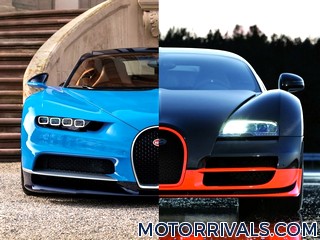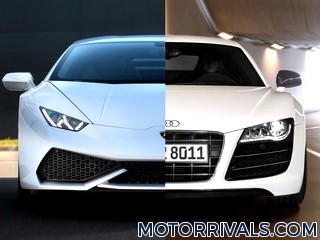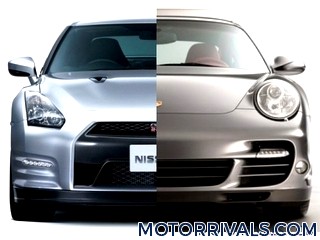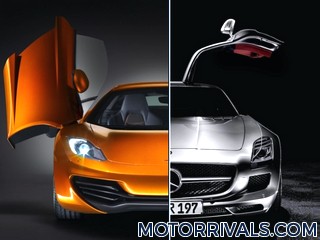2016 McLaren P1 vs 2016 Porsche 918 Spyder
McLaren P1 Press Release Highlights
The astonishing new McLaren P1, which debuts in production form at the
Geneva Motor Show, has a clear goal – to be the best driver’s car in the
world on road and track. To achieve this objective, McLaren is using all
of its 50 years of racing experience and success, especially in the
fields of aerodynamics and lightweight carbon fibre technology.
The result is a car that has an unprecedented amount of downforce for a road vehicle: similar levels to a GT3 racing car and yet with even greater ground effect. This downforce not only boosts cornering and braking performance. It also helps balance, stability and driveability at all speeds.
The best driver’s car in the world must also have exceptional straight-line performance and instant throttle response. To deliver this, the McLaren P1 uses an innovative IPAS petrol-electric powertrain comprising a substantially revised 3.8-litre twin-turbo V8 petrol engine, coupled to a single electric motor, collectively known as M838TQ. Combined power output is 916 PS (903 hp). As important as absolute power is the electric motor’s ability to provide instant torque, making the powertrain superbly responsive. It is also amazingly efficient. Carbon dioxide emissions are less than 200g/km, and it can cover more than 10 km in electric-only mode.
Top speed is electronically limited to 350 km/h (217 mph), with the 0-100 km/h standing start acceleration taking less than three seconds .The McLaren P1 will power from rest to 200 km/h in less than seven seconds, and on to 300 km/h in less than 17 seconds – a full five seconds quicker than the McLaren F1.
The astonishing technology developed for the McLaren P1 includes active aerodynamics and adjustable suspension – both now banned in Formula 1, due to being seen to give a performance advantage. Airflow is optimised around the body through the use of an active wing and underbody devices. The adjustable rear wing can extend from the bodywork by 120mm on road, up to 300mm on the race track, maximising the levels of downforce. The wing is directly inspired by Formula 1 design, with the intersection of the double element rear wing and design of the endplates being the same as that on the 2008 championship winning MP4-23.
In addition, the McLaren P1 also features adjustable ride height as part of the new hydro-pneumatic suspension. The revolutionary RaceActive Chassis Control (RCC) can lower the car by 50mm in Race mode, to produce ground effect aerodynamics. It also features adaptive spring rates, roll control, pitch control and damping, all providing a huge range of adjustment, making the McLaren P1 perfect for either road or track. In Race mode, the spring rates stiffen by 300 per cent, allowing the McLaren P1 to corner at more than 2g.
Formula 1-inspired technology permeates the McLaren P1. The revolutionary new carbon fibre MonoCage monocoque forms a complete structure incorporating the vehicle’s roof and its distinctive snorkel air intake - a styling feature inspired by the McLaren F1 road car.
McLaren is an acknowledged world leader in carbon technology. The material offers lightness, strength and rigidity – improving performance, safety, handling, agility, durability, efficiency and ride comfort. The body panels of the McLaren P1 are also made from lightweight yet strong carbon composite, with their complex shapes tuned for optimal aerodynamics.
The McLaren P1 was designed from the outset to prioritise aerodynamic performance – just like a Formula 1 car. As with a Formula 1 car, wind tunnel testing and CFD (computational fluid dynamics) aerodynamic modelling were used to optimise the aerodynamic flow, both to provide incredible levels of downforce and to cool the powertrain. The result is 600kg of downforce at well below maximum speed (257 km/h / 161 mph) in Race mode, which is considerably higher than most other high performance supercars, and more in line with the levels of downforce generated by a GT3 racing car. This downforce improves the car’s cornering ability, especially in high speed corners. Balance, agility and controllability are all outstanding.
Other areas of Formula 1 technology evident on the McLaren P1 include the revolutionary layered carbon ceramic brakes, developed for the road by McLaren’s Formula 1 partners Akebono. The highly efficient IPAS (Instant Power Assist System) is a development of KERS (Kinetic Energy Recovery System) used on Formula 1 cars, while DRS (Drag Reduction System) is also used on the McLaren P1, giving extra power and straight-line speed both at the touch of a button. Brake Steer – an outlawed Formula 1 technology – is also used on the McLaren P1. It improves cornering behaviour and cornering speed.
The IPAS petrol-electric powertrain also ties in with upcoming Formula 1 regulations. From next year (2014), Formula 1 cars will have hybrid power, including an electric mode for the pit lane.
The McLaren P1 name is also inspired by Formula 1. P1 refers to ‘first place’ or ‘position one’ – particularly fitting as McLaren has 182 Grand Prix victories and 155 pole positions to-date, in its 47-year Formula 1 history. There is also heritage in that name: the McLaren F1 was initially known internally within McLaren as Project 1, or P1.
Despite the huge performance, the McLaren P1 is also a refined and comfortable high-speed supercar. ‘It is designed to be driven to the racing circuit, with great levels of comfort and refinement,’ says McLaren P1 programme director, Paul Mackenzie. ‘And then to be used on the racing circuit, where it will offer an experience matched only by purpose-built race cars.’
The ownership experience with the McLaren P1 will be as special as the car itself, Greg Levine, McLaren Automotive Sales and Marketing Director explains: “Owners will become part of the McLaren family, if they aren’t already. To maintain exclusivity, we have closely monitored demand, and announced a production number of just 375 units – a figure that will ensure the McLaren P1 will remain a rarity and, if spotted on the road, an unforgettable sight.”
The result is a car that has an unprecedented amount of downforce for a road vehicle: similar levels to a GT3 racing car and yet with even greater ground effect. This downforce not only boosts cornering and braking performance. It also helps balance, stability and driveability at all speeds.
The best driver’s car in the world must also have exceptional straight-line performance and instant throttle response. To deliver this, the McLaren P1 uses an innovative IPAS petrol-electric powertrain comprising a substantially revised 3.8-litre twin-turbo V8 petrol engine, coupled to a single electric motor, collectively known as M838TQ. Combined power output is 916 PS (903 hp). As important as absolute power is the electric motor’s ability to provide instant torque, making the powertrain superbly responsive. It is also amazingly efficient. Carbon dioxide emissions are less than 200g/km, and it can cover more than 10 km in electric-only mode.
Top speed is electronically limited to 350 km/h (217 mph), with the 0-100 km/h standing start acceleration taking less than three seconds .The McLaren P1 will power from rest to 200 km/h in less than seven seconds, and on to 300 km/h in less than 17 seconds – a full five seconds quicker than the McLaren F1.
The astonishing technology developed for the McLaren P1 includes active aerodynamics and adjustable suspension – both now banned in Formula 1, due to being seen to give a performance advantage. Airflow is optimised around the body through the use of an active wing and underbody devices. The adjustable rear wing can extend from the bodywork by 120mm on road, up to 300mm on the race track, maximising the levels of downforce. The wing is directly inspired by Formula 1 design, with the intersection of the double element rear wing and design of the endplates being the same as that on the 2008 championship winning MP4-23.
In addition, the McLaren P1 also features adjustable ride height as part of the new hydro-pneumatic suspension. The revolutionary RaceActive Chassis Control (RCC) can lower the car by 50mm in Race mode, to produce ground effect aerodynamics. It also features adaptive spring rates, roll control, pitch control and damping, all providing a huge range of adjustment, making the McLaren P1 perfect for either road or track. In Race mode, the spring rates stiffen by 300 per cent, allowing the McLaren P1 to corner at more than 2g.
Formula 1-inspired technology permeates the McLaren P1. The revolutionary new carbon fibre MonoCage monocoque forms a complete structure incorporating the vehicle’s roof and its distinctive snorkel air intake - a styling feature inspired by the McLaren F1 road car.
McLaren is an acknowledged world leader in carbon technology. The material offers lightness, strength and rigidity – improving performance, safety, handling, agility, durability, efficiency and ride comfort. The body panels of the McLaren P1 are also made from lightweight yet strong carbon composite, with their complex shapes tuned for optimal aerodynamics.
The McLaren P1 was designed from the outset to prioritise aerodynamic performance – just like a Formula 1 car. As with a Formula 1 car, wind tunnel testing and CFD (computational fluid dynamics) aerodynamic modelling were used to optimise the aerodynamic flow, both to provide incredible levels of downforce and to cool the powertrain. The result is 600kg of downforce at well below maximum speed (257 km/h / 161 mph) in Race mode, which is considerably higher than most other high performance supercars, and more in line with the levels of downforce generated by a GT3 racing car. This downforce improves the car’s cornering ability, especially in high speed corners. Balance, agility and controllability are all outstanding.
Other areas of Formula 1 technology evident on the McLaren P1 include the revolutionary layered carbon ceramic brakes, developed for the road by McLaren’s Formula 1 partners Akebono. The highly efficient IPAS (Instant Power Assist System) is a development of KERS (Kinetic Energy Recovery System) used on Formula 1 cars, while DRS (Drag Reduction System) is also used on the McLaren P1, giving extra power and straight-line speed both at the touch of a button. Brake Steer – an outlawed Formula 1 technology – is also used on the McLaren P1. It improves cornering behaviour and cornering speed.
The IPAS petrol-electric powertrain also ties in with upcoming Formula 1 regulations. From next year (2014), Formula 1 cars will have hybrid power, including an electric mode for the pit lane.
The McLaren P1 name is also inspired by Formula 1. P1 refers to ‘first place’ or ‘position one’ – particularly fitting as McLaren has 182 Grand Prix victories and 155 pole positions to-date, in its 47-year Formula 1 history. There is also heritage in that name: the McLaren F1 was initially known internally within McLaren as Project 1, or P1.
Despite the huge performance, the McLaren P1 is also a refined and comfortable high-speed supercar. ‘It is designed to be driven to the racing circuit, with great levels of comfort and refinement,’ says McLaren P1 programme director, Paul Mackenzie. ‘And then to be used on the racing circuit, where it will offer an experience matched only by purpose-built race cars.’
The ownership experience with the McLaren P1 will be as special as the car itself, Greg Levine, McLaren Automotive Sales and Marketing Director explains: “Owners will become part of the McLaren family, if they aren’t already. To maintain exclusivity, we have closely monitored demand, and announced a production number of just 375 units – a figure that will ensure the McLaren P1 will remain a rarity and, if spotted on the road, an unforgettable sight.”
Porsche 918 Spyder Press Release Highlights
The 918 Spyder embodies the essence of the Porsche idea: it combines
pedigree motor racing technology with excellent everyday utility, and
maximum performance with minimum consumption. The task faced by the
development team was to create the super sports car for the next decade
with a highly efficient and powerful hybrid drive. Developing the car
from scratch, appropriately beginning with a sheet of white paper,
allowed the team to come up with a no-compromise concept. The entire car
was designed around the hybrid drive. The 918 Spyder therefore
demonstrates the potential of the hybrid drive to a degree never seen
before: the parallel improvement of both efficiency and performance
without one being at the cost of the other. This is the idea that has
made the Porsche 911 the most successful sports car in the world for 50
years. In short, the 918 Spyder will act as the gene pool for the
Porsche sports cars of the future.
The Porsche 918 Spyder also has the potential to break many records. The current lap time for the North Loop of the Nürburgring is 7:14 minutes. This time was achieved in the presence of international journalists during test drives in September 2012 – more than a year before start of production. The 918 Spyder prototype was therefore approximately 20 seconds quicker than the Porsche Carrera GT. More test drives on the Nürburgring North Loop will follow. An even more important factor is that the 918 Spyder surpasses previous models and competitors by far in its efficiency as well. As a plug-in hybrid vehicle, it systematically combines the dynamic performance of a racing machine with low fuel consumption. To sum it up: maximum driving fun with minimal fuel consumption.
Carbon monocoque guarantees lightweight design with a low center of gravity
The 918 Spyder utilizes the best state-of-the-art technologies, taken straight from motor racing, to achieve its top performance. The entire load-bearing structure is made of carbon fiber reinforced polymer (CFRP) for extreme torsional rigidity. Additional crash elements at the front and rear absorb and reduce the energy of a collision. The car’s unladen weight of approximately 3,715 lbs. (3,616 lbs. with “Weissach" package), an excellent low weight for a hybrid vehicle of this performance class, is largely attributable to this concept.
The drivetrain components and all components weighing over 110 lbs. are located as low and as centrally as possible within the vehicle. This results in a slightly rear end biased axle load distribution of 57 percent on the rear axle and 43 percent on the front axle, combined with an extremely low center of gravity at approximately the height of the wheel hubs, which is ideal for driving dynamics. The central and low position of the traction battery directly behind the driver not only supports efforts to concentrate masses and lower the center of gravity; it also provides the best temperature conditions for optimum battery power capacity.
Quiet and elegant: “E-Power"
When the vehicle is started up, the “E-Power" mode is the default operating mode as long as the battery is sufficiently charged. In ideal conditions, the 918 Spyder can cover approximately 18 miles on purely electric power. Even in pure electric mode, the 918 Spyder accelerates from 0 to 62 mph in seven seconds and can reach speeds of up to 93 mph. In this mode, the combustion engine is only used when needed. If the battery’s charge state drops below a set minimum value, the vehicle automatically switches to hybrid mode.
Main propulsion: the race car’s eight cylinder engine
The main source of propulsion is the 4.6-liter, eight cylinder engine that produces 608 hp of power. The engine is derived directly from the power unit of the successful RS Spyder, which explains why it can deliver engine speeds of up to 9,150 rpm. Like the race engine of the RS Spyder, the 918 Spyder power unit features dry-sump lubrication with a separate oil tank and oil extraction. To save weight, components such as the oil tank, the air filter box integrated into the subframe and the air induction are made of carbon fiber reinforced polymer. Further extensive lightweight design measures have resulted in such features as titanium connecting rods, thin-wall, low-pressure casting on the crank case and the cylinder heads, a high-strength, lightweight steel crankshaft with 180 degrees crankpin offset and the extremely thin-walled alloy steel/nickel exhaust system. Striking features of the V8 are that it no longer supports any auxiliary systems, there are no external belt drives and the engine is therefore particularly compact. Weight and performance optimizations achieve a power output per liter of approx. 133 hp/l – the highest power output per liter of a Porsche naturally aspirated engine – which is significantly higher than that of the Carrera GT (106 hp/l) and outstanding for a naturally aspirated engine.
Independent all-wheel drive: front axle with electric motor
On the front axle, there is another independent electric motor with an output of approximately 95 kW. The front electric drive unit drives the wheels at a fixed ratio. A decoupler decouples the electric motor at high speeds to prevent the motor from over-revving. Drive torque is independently controlled for each axle. This makes for very responsive all-wheel drive functionality that offers great potential in terms of traction and driving dynamics.
The Porsche 918 Spyder also has the potential to break many records. The current lap time for the North Loop of the Nürburgring is 7:14 minutes. This time was achieved in the presence of international journalists during test drives in September 2012 – more than a year before start of production. The 918 Spyder prototype was therefore approximately 20 seconds quicker than the Porsche Carrera GT. More test drives on the Nürburgring North Loop will follow. An even more important factor is that the 918 Spyder surpasses previous models and competitors by far in its efficiency as well. As a plug-in hybrid vehicle, it systematically combines the dynamic performance of a racing machine with low fuel consumption. To sum it up: maximum driving fun with minimal fuel consumption.
Carbon monocoque guarantees lightweight design with a low center of gravity
The 918 Spyder utilizes the best state-of-the-art technologies, taken straight from motor racing, to achieve its top performance. The entire load-bearing structure is made of carbon fiber reinforced polymer (CFRP) for extreme torsional rigidity. Additional crash elements at the front and rear absorb and reduce the energy of a collision. The car’s unladen weight of approximately 3,715 lbs. (3,616 lbs. with “Weissach" package), an excellent low weight for a hybrid vehicle of this performance class, is largely attributable to this concept.
The drivetrain components and all components weighing over 110 lbs. are located as low and as centrally as possible within the vehicle. This results in a slightly rear end biased axle load distribution of 57 percent on the rear axle and 43 percent on the front axle, combined with an extremely low center of gravity at approximately the height of the wheel hubs, which is ideal for driving dynamics. The central and low position of the traction battery directly behind the driver not only supports efforts to concentrate masses and lower the center of gravity; it also provides the best temperature conditions for optimum battery power capacity.
Quiet and elegant: “E-Power"
When the vehicle is started up, the “E-Power" mode is the default operating mode as long as the battery is sufficiently charged. In ideal conditions, the 918 Spyder can cover approximately 18 miles on purely electric power. Even in pure electric mode, the 918 Spyder accelerates from 0 to 62 mph in seven seconds and can reach speeds of up to 93 mph. In this mode, the combustion engine is only used when needed. If the battery’s charge state drops below a set minimum value, the vehicle automatically switches to hybrid mode.
Main propulsion: the race car’s eight cylinder engine
The main source of propulsion is the 4.6-liter, eight cylinder engine that produces 608 hp of power. The engine is derived directly from the power unit of the successful RS Spyder, which explains why it can deliver engine speeds of up to 9,150 rpm. Like the race engine of the RS Spyder, the 918 Spyder power unit features dry-sump lubrication with a separate oil tank and oil extraction. To save weight, components such as the oil tank, the air filter box integrated into the subframe and the air induction are made of carbon fiber reinforced polymer. Further extensive lightweight design measures have resulted in such features as titanium connecting rods, thin-wall, low-pressure casting on the crank case and the cylinder heads, a high-strength, lightweight steel crankshaft with 180 degrees crankpin offset and the extremely thin-walled alloy steel/nickel exhaust system. Striking features of the V8 are that it no longer supports any auxiliary systems, there are no external belt drives and the engine is therefore particularly compact. Weight and performance optimizations achieve a power output per liter of approx. 133 hp/l – the highest power output per liter of a Porsche naturally aspirated engine – which is significantly higher than that of the Carrera GT (106 hp/l) and outstanding for a naturally aspirated engine.
Independent all-wheel drive: front axle with electric motor
On the front axle, there is another independent electric motor with an output of approximately 95 kW. The front electric drive unit drives the wheels at a fixed ratio. A decoupler decouples the electric motor at high speeds to prevent the motor from over-revving. Drive torque is independently controlled for each axle. This makes for very responsive all-wheel drive functionality that offers great potential in terms of traction and driving dynamics.






















